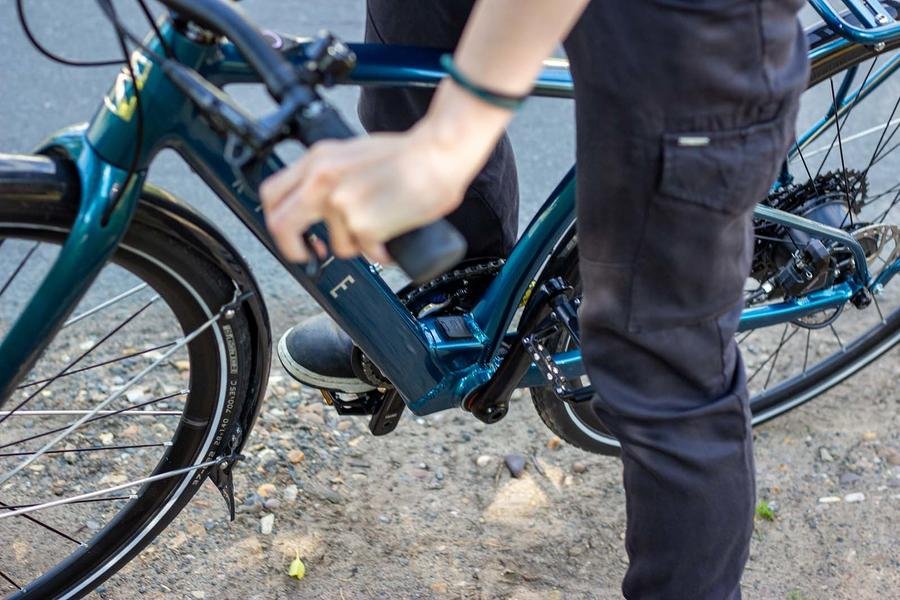Electric bike FAQs: Everything you want to know about e-bikes

Whether you’re buying one or just interested to learn more, electric bikes can look like complicated bits of kit. How do you know where you can ride them, and do you need insurance? With so much information floating around it’s easy to get confused, so we’ve answered some of the burning questions people may have about electric bikes.
Can I ride my e-bike in the rain?
Yes! They are more resilient than you realise. We’re not saying you should ride them in the sea, but most bikes are designed to divert the water away from the electronic components including the battery and motor. This means that it is possible to ride in heavy rain, so make sure you invest in a good coat.
Will the motor provide assistance if I don’t pedal?
In short, no. In the UK at least, an e-bike motor must only work in conjunction with the rider pedalling. Thus, if you stop pedalling, the motor will turn off and not provide assistance. Certain S-Pedelecs use throttles but they require licensing and insurance and are uncommon in the UK due to these barriers.
Can I use a pressure washer to clean my e-bike?
Using a powerful pressure washer can cause damage to the bike, so it’s best to use the old fashioned method of a bucket and some soapy water or specialist bicycle detergent. If you subject your bike to a powerful stream of water, you might find that your bearings wear out quicker as the grease may have washed away. It may also impact the electronics on your bike. When washing, make sure that the charge port is covered, and if your battery is easily removable, do so.
Do I need insurance to ride my e-bike?
No. As they are classed as bicycles, you are under no obligation to insure them. You may, however, want to consider it if it cost you a lot and you're worried about theft. Specialist bike insurers will cover your bike away from home, but you'll need to check with your home insurer to see if they offer the same coverage.
What’s the legal max speed of an e-bike in the UK?
The e-bike motor is legally only able to provide assistance up to 15.5mph or 25km/h. You can, however, go faster with some good old fashioned pedalling.
What is ‘chipping’ and can I legally do it to my e-bike?
Chipping is essentially removing the pedal assistance limiter on your bike. By removing the limiter, the bike motor will be able to assist at speeds higher than before, i.e. above 15.5mph. The laws in place state an e-bike motor can only assist up to a maximum speed of 15.5mph. The bike can travel faster than this but it must be under your own steam. By removing this limiter you’ll be pushing it into S-Pedelec territory where it will require licensing and insurance. Additionally, while it might be appealing to want to make your bike travel at 30mph without much effort, it can negatively impact the motor as they are designed to be used at regulated speeds.
Where can I ride my e-bike?
You can ride your e-bike anywhere an unassisted cycle can go. This includes on the road, cycle paths, bridleways, and trails.
Why are electric bikes costly?
Bikes have come a long way since the simple safety bicycle, and with this development in technology, especially motors and batteries, comes added costs. Additionally, certain drivetrain components such as the chains need to be made more durable to withstand the extra weight and force put through them, so will all this research development comes a larger price tag. You can get a decent e-bike for under £1,000, but you can also spend upwards of £10,000. How much you spend depends on what type of riding you want to do, and the quality of the components.
How far can an electric bike go?
This depends on the battery and the type of riding you will be doing. If your ride is into a headwind and up multiple hills, your battery won’t last as long as an easier flatter ride. It also depends on the level of assist you use. If you use a higher assist level, the battery will drain much quicker.
Can I ride my e-bike if it has a flat battery?
Most if not all electric bikes are still functional without the battery and motor. Once the battery is drained, all it means is the electronic functions won’t work, i.e. the battery/motor. So you can still pedal the bike, it will just be a lot harder! If you have lights that are wired into your bike, these will also be turned off, so make sure you try to avoid draining your battery while on a ride.
Do I need a license to ride an e-bike on the roads?
No. E-bikes are classed as bicycles and thus are not subject to licensing requirements.
Related News
